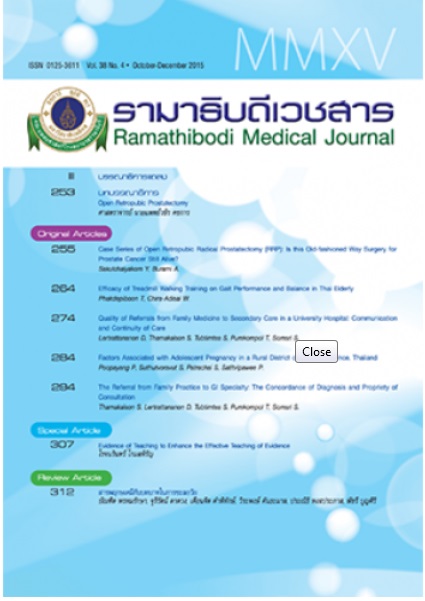Efficacy of Treadmill Walking Training on Gait Performance and Balance in Thai Elderly
Keywords:
Treadmill Walking Training, Gait performance, Elderly, BalanceAbstract
Objectives: To evaluate the effect of a 4-week treadmill walking on balance and gait performance in Thai elderly.
Study Design: Experimental research, pretest-posttest one group design
Setting: Rehabilitation Medicine Department, Faculty of medicine Ramathibodi Hospital
Subjects: Thai elderly aged 60 or older and volunteered to participate in the study
Methods: A 30-minute treadmill walking at each individual comfortable speed was set as 2 times per week for 4 weeks. At baseline and 4 weeks, participants were tested in their static balance by Single-Leg Stance Test with eyes open and close (SLST-EO and SLST-EC), dynamic balance by Expanded Timed Up and Go Test (ETUG) and gait velocity were measured.
Results: Twenty-four elderly with mean age (standard deviation) of 65 (4.4) were recruited. The SLST-EO [median(interquartile range, IQR)] of right, left leg for pre and post training were [20.70 (15.60-63.00)], [20.36 (10.80-67.27)] and [38.00 (20.17-74.19)], [26.52 (14.61-72.39)] sec, respectively. The SLST-EC [median (interquartile range, IQR)] of right, left leg for pre and post training were [4.20 (3.42-9.29)], [4.00 (2.89-7.91)] and [6.85 (2.70-13.62)], [4.96 (3.91-12.59)] sec, respectively. ETUG, gait velocity [mean(standard deviation)] of pre training were [22.37 (3.15)] sec, [1.08 (0.15)] m/s and post training were [20.54 (2.12)] sec, [1.14 (0.15) ]m/s, respectively. All parameters in post training were statistically improved. (P < 0.05)
Conclusion: A 4 week, twice weekly, treadmill walking training is able to improved balance, both dynamic and static, and gait velocity in Thai elderly.
References
Prince F, Corriveau H, Hebert R, Winter D. Review article gait in the elderly. Gait Posture. 1997;5:128-35.
Gillespie LD, Robertson MC, Gillespie WJ, et al. Interventions for preventing falls in older people living in the community. Cochrane Database Syst Rev. 2012;(9):CD007146. doi:10.1002/14651858.CD007146.pub3.
Fritz S, Lusardi M. White paper: "walking speed: the sixth vital sign". J Geriatr Phys Ther. 2009;32(2):46-9.
Arnold CM, Sran MM, Harrison EL. Exercise for fall risk reduction in community-dwelling older adults: a systematic review. Physiother Can. 2008;60(4):358-72. doi:10.3138/physio.60.4.358.
Obuchi S, Kojima M, Shiba Y, Shimada H, Suzuki T. A randomized controlled trial of a treadmill training with the perturbation to improve the balance performance in the community dwelling elderly subjects. Nihon Ronen Igakkai Zasshi. 2004;41(3):321-7.
Assantachai P, Praditsuwan R, Chatthanawaree W, Pisalsarakij D, Thamlikitkul V. Risk factors for falls in the Thai elderly in an urban community. J Med Assoc Thai. 2003;86(2):124-30.
Malatesta D, Simar D, Ben Saad H, Préfaut C, Caillaud C. Effect of an overground walking training on gait performance in healthy 65- to 80-year-olds. Exp Gerontol. 2010;45(6):427-34. doi:10.1016/j.exger.2010.03.009.
Lee SJ, Hidler J. Biomechanics of overground vs. treadmill walking in healthy individuals. J Appl Physiol. 2008;104(3):747-55.
Carmeli E, Kessel S, Coleman R, Ayalon M. Effects of a treadmill walking program on muscle strength and balance in elderly people with Down syndrome. J Gerontol A Biol Sci Med Sci. 2002;57(2):M106-10.
Parvataneni K, Ploeg L, Olney SJ, Brouwer B. Kinematic, kinetic and metabolic parameters of treadmill versus overground walking in healthy older adults. Clin Biomech. 2009;24(1):95-100. doi: 10.1016/j.clinbiomech.2008.07.002.
Sherrington C, Whitney JC, Lord SR, Herbert RD, Cumming RG, Close JC. Effective exercise for the prevention of falls: a systematic review and meta-analysis. J Am Geriatr Soc. 2008;56(12):2234-43. doi:10.1111/j.1532-5415.2008.02014.x.
Kumkate B, Wongpat P, Sanjaroensuttikul N. Effect of Tai Chi Chun exercise on balance in Thai elderly people. J Thai. Rehabil Med 2007; 17(3): 73-8.
Kuptniratsaikul V, Dajpratham P, Praditsuwan R. The time up & go a practical basic mobility skills assessment in the elderly. Siriraj Med. 2006;58:588-91.
Steffen TM, Hacker TA, Mollinger L. Age- and gender-related test performance in community-dwelling elderly people: six-minute walk test, berg balance scale, timed up & go test, and gait speeds. Phys Ther. 2002;82:128-37.
Wass E, Taylor NF, Matsas A. Familiarisation to treadmill walking in unimpaired older people. Gait Posture. 2005;21(1):72-9.
Kuptniratsaikul V, Praditsuwan R, Assantachai P, Ploypetch T, Udompunturak S, Pooliam J. Effectiveness of simple balancing training program in elderly patients with history of frequent falls. Clin Interv Aging. 2011;6:111-7. doi:10.2147/CIA.S17851.
Petridou ET, Manti EG, Ntinapogias AG, Negri E, Szczerbinska K. What works better for community-dwelling older people at risk to fall?: a meta-analysis of multifactorial versus physical exercise-alone interventions. J Aging Health. 2009;21(5):713-29. doi: 10.1177/0898264309338298.
Wall JC, Bell C, Campbell S, Davis J. The Timed Get-up-and-Go test revisited: measurement of the component tasks. J Rehabil Res Dev. 2000;37(1):109-13.
Gehlsen GM, Whaley MH. Falls in the elderly: Part II, Balance, strength, and flexibility. Arch Phys Med Rehabil. 1990;71(10):739-41.
Quach L, Galica AM, Jones RN, et al. The nonlinear relationship between gait speed and falls: the maintenance of balance, independent living, intellect, and Zest in the elderly of Boston study. J Am Geriatr Soc. 2011;59(6):1069-73. doi:10.1111/j.1532-5415.2011.03408.x.
Downloads
How to Cite
Issue
Section
License
Copyright (c) 2015 By the authors. Licensee RMJ, Faculty of Medicine Ramathibodi Hospital, Mahidol University, Bangkok, Thailand

This work is licensed under a Creative Commons Attribution-NonCommercial-NoDerivatives 4.0 International License.













